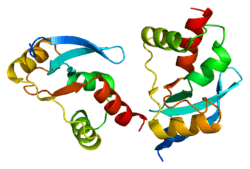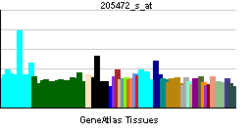DACH1
Dachshund homolog 1 (Drosophila), also known as DACH1, is a protein which in humans is encoded by the DACH1 gene.[1][2][3]
Function
This gene is similar to the D. melanogaster dachshund gene, which encodes a nuclear factor essential for determining cell fates in the eye, leg, and nervous system of the fly. It is a member of the Ski gene family and is thought to be involved in eye development. Four alternatively spliced transcripts encoding different isoforms have been described for this gene.[3]
Interactions
DACH1 has been shown to interact with UBE2I.[4][5]
References
- ↑ Hammond KL, Lettice LA, Hill RE, Lee M, Boyle S, Hanson IM (January 1999). "Human (DACH) and mouse (Dach) homologues of Drosophila dachshund map to chromosomes 13q22 and 14E3, respectively". Genomics 55 (2): 252–253. doi:10.1006/geno.1998.5662. PMID 9933575.
- ↑ Kozmik Z, Cvekl A (July 1999). "Localization of the human homologue of the Drosophila dachshund gene (DACH) to chromosome 13q21". Genomics 59 (1): 110–111. doi:10.1006/geno.1999.5797. PMID 10395809.
- ↑ 3.0 3.1 "Entrez Gene: DACH1 dachshund homolog 1 (Drosophila)".
- ↑ Rual JF, Venkatesan K, Hao T, Hirozane-Kishikawa T, Dricot A, Li N et al. (October 2005). "Towards a proteome-scale map of the human protein-protein interaction network". Nature 437 (7062): 1173–1178. doi:10.1038/nature04209. PMID 16189514.
- ↑ Machon O, Backman M, Julin K, Krauss S (October 2000). "Yeast two-hybrid system identifies the ubiquitin-conjugating enzyme mUbc9 as a potential partner of mouse Dac". Mech. Dev. 97 (1–2): 3–12. doi:10.1016/S0925-4773(00)00402-0. PMID 11025202.
Further reading
- Hammond KL, Hanson IM, Brown AG, Lettice LA, Hill RE (2003). "Mammalian and Drosophila dachshund genes are related to the Ski proto-oncogene and are expressed in eye and limb". Mech. Dev. 74 (1–2): 121–131. doi:10.1016/S0925-4773(98)00071-9. PMID 9651501.
- Hammond KL, Lettice LA, Hill RE, Lee M, Boyle S, Hanson IM (1999). "Human (DACH) and mouse (Dach) homologues of Drosophila dachshund map to chromosomes 13q22 and 14E3, respectively". Genomics 55 (2): 252–253. doi:10.1006/geno.1998.5662. PMID 9933575.
- Kozmik Z, Cvekl A (1999). "Localization of the human homologue of the Drosophila dachshund gene (DACH) to chromosome 13q21". Genomics 59 (1): 110–111. doi:10.1006/geno.1999.5797. PMID 10395809.
- Kozmik Z, Pfeffer P, Kralova J, Paces J, Paces V, Kalousova A et al. (1999). "Molecular cloning and expression of the human and mouse homologues of the Drosophila dachshund gene". Dev. Genes Evol. 209 (9): 537–545. doi:10.1007/s004270050286. PMID 10502110.
- Machon O, Backman M, Julin K, Krauss S (2001). "Yeast two-hybrid system identifies the ubiquitin-conjugating enzyme mUbc9 as a potential partner of mouse Dac". Mech. Dev. 97 (1–2): 3–12. doi:10.1016/S0925-4773(00)00402-0. PMID 11025202.
- Ayres JA, Shum L, Akarsu AN, Dashner R, Takahashi K, Ikura T et al. (2001). "DACH: genomic characterization, evaluation as a candidate for postaxial polydactyly type A2, and developmental expression pattern of the mouse homologue". Genomics 77 (1–2): 18–26. doi:10.1006/geno.2001.6618. PMID 11543628.
- Ozaki H, Watanabe Y, Ikeda K, Kawakami K (2002). "Impaired interactions between mouse Eyal harboring mutations found in patients with branchio-oto-renal syndrome and Six, Dach, and G proteins". J. Hum. Genet. 47 (3): 0107–0116. doi:10.1007/s100380200011. PMID 11950062.
- Kim SS, Zhang RG, Braunstein SE, Joachimiak A, Cvekl A, Hegde RS (2003). "Structure of the retinal determination protein Dachshund reveals a DNA binding motif". Structure 10 (6): 787–795. doi:10.1016/S0969-2126(02)00769-4. PMID 12057194.
- Ikeda K, Watanabe Y, Ohto H, Kawakami K (2002). "Molecular interaction and synergistic activation of a promoter by Six, Eya, and Dach proteins mediated through CREB binding protein". Mol. Cell. Biol. 22 (19): 6759–6766. doi:10.1128/MCB.22.19.6759-6766.2002. PMC 134036. PMID 12215533.
- Wu K, Yang Y, Wang C, Davoli MA, D'Amico M, Li A et al. (2004). "DACH1 inhibits transforming growth factor-beta signaling through binding Smad4". J. Biol. Chem. 278 (51): 51673–51684. doi:10.1074/jbc.M310021200. PMID 14525983.
- Nobrega MA, Ovcharenko I, Afzal V, Rubin EM (2003). "Scanning human gene deserts for long-range enhancers". Science 302 (5644): 413–413. doi:10.1126/science.1088328. PMID 14563999.
- Li X, Oghi KA, Zhang J, Krones A, Bush KT, Glass CK et al. (2003). "Eya protein phosphatase activity regulates Six1-Dach-Eya transcriptional effects in mammalian organogenesis". Nature 426 (6964): 247–254. doi:10.1038/nature02083. PMID 14628042.
- Martini SR, Davis RL (2005). "The dachshund gene is required for the proper guidance and branching of mushroom body axons in Drosophila melanogaster". J. Neurobiol. 64 (2): 133–144. doi:10.1002/neu.20130. PMID 15818552.
- Rual JF, Venkatesan K, Hao T, Hirozane-Kishikawa T, Dricot A, Li N et al. (2005). "Towards a proteome-scale map of the human protein-protein interaction network". Nature 437 (7062): 1173–1178. doi:10.1038/nature04209. PMID 16189514.
- Wu K, Li A, Rao M, Liu M, Dailey V, Yang Y et al. (2006). "DACH1 is a cell fate determination factor that inhibits cyclin D1 and breast tumor growth". Mol. Cell. Biol. 26 (19): 7116–7129. doi:10.1128/MCB.00268-06. PMC 1592900. PMID 16980615.
| |||||||||



